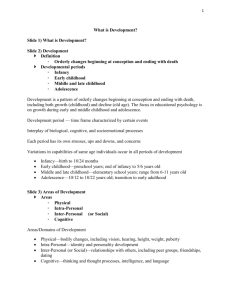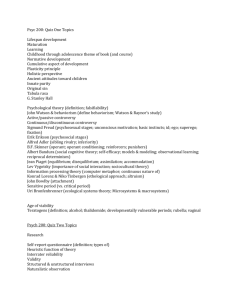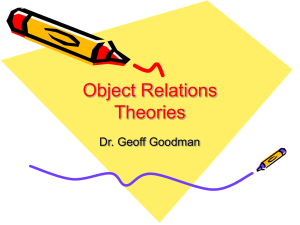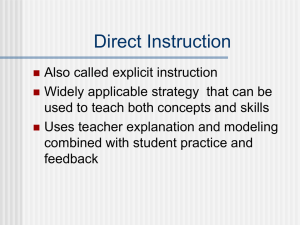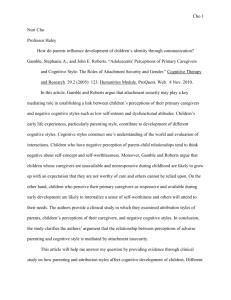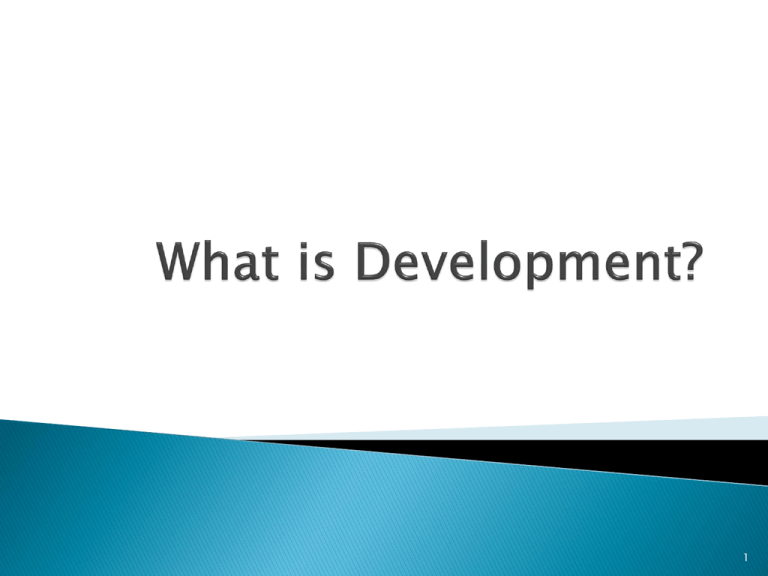
1
Definition
◦ Orderly changes beginning at conception and
ending with death
Developmental periods
◦
◦
◦
◦
Infancy
Early childhood
Middle and late childhood
Adolescence
2
Areas
◦ Physical
◦ Intra-Personal
◦ Inter-Personal
Social)
◦ Cognitive
(or
3
Nature-nurture debate
Stability and change
Continuity and discontinuity
4
Discontinuous
Development
Continuous
Development
5
6
Describe the three developmental issues:
nature versus nurture, stability versus
change, and continuity versus discontinuity.
Apply the three developmental issues to Ted
Bundy.
7
Development occurs
◦ gradually,
◦ relatively orderly in a predictable pattern, and
◦ at varying rates for individuals.
8
Context
◦ Normative age-graded
◦ Normative history-graded
◦ Non-normative
9
Explore normative age-graded, normative
history-graded, and non-normative
developmental contexts that can affect
learning in your future students.
10
11
Theory
Hypothesis
Why are there so many theories?
12
Psychoanalytic
Cognitive
Behavioral
Social Cognitive
Ethological
Ecological
Eclectic Orientation
13
Major premises
◦ Role of emotions
◦ Role of the unconscious
Major theorists
◦ Freud
◦ Erikson
14
Unconscious
Personality development
◦ Id
◦ Ego
◦ Superego
Defense mechanisms
Series of psychosexual
development stages
15
Motivation is affiliation (not sex)
Development is not confined to early
childhood
Development continues across the life span
16
Freudian Theory
◦ Consider that unconscious drives or motives may
affect classroom behavior
◦ Defense mechanisms, such as rationalization and
denial may be used by students to reduce their
feelings of anxiety during a conflict or
confrontation
Erikson’s Theory
◦ Provide ample opportunities for students to be
successful and praise their effort and work ethic
◦ Provide positive role models for students
17
What similarities are found between Freud’s
and Erikson’s theories?
Why is it beneficial to examine identity
development across the life span?
◦ How might developmental contexts affect identity
development?
18
Major premise
◦ Emphasize role of conscious thought
Major theorists
◦ Piaget
◦ Vygotsky
◦ Information Processing
19
Major premises:
◦
◦
◦
◦
Maturation is basis for development.
Children are active and curious.
Children construct their own knowledge.
Children want to maintain a mental homeostatic
environment.
Stage theory of cognitive development
beginning at birth and continuing through
adolescence.
20
Major premises:
◦ Society and culture impact cognitive development
◦ Knowledge is co-constructed between a learner and
a more knowledgeable other
◦ Language guides thinking and learning
◦ Mental processes begin as social activity typically
utilizing language and then internalized
21
Based on computer model to describe how
the human brain works.
Thinking occurs through the following
processes:
◦ Encoding
◦ Storage
◦ Retrieval
22
Piaget
◦ Require student to interact with environment and
formulate own ideas
◦ Challenge student misconceptions
Vygotsky
◦ Use peer assisted learning
◦ Aim instruction beyond students’ current level of
knowledge
◦ Provide students with multiple perspectives from
knowledgeable peers or adults
23
Information Processing
◦ Gain students attention before beginning
instruction or providing direction
◦ Activate students’ prior knowledge
◦ Make learning meaningful to students’ lives and
experiences
◦ Focus on important overarching aspects of lessons
◦ Use active learning
24
Compare and contrast Piaget’s and
Vygotsky’s theories of cognitive development.
What implications do these theories have for
your teaching your future students?
How does the information processing theory
help you to understand the learning process
in which students engage during class?
25
Major premises:
◦ Learning and development are described in
observable terms
◦ Environment and experiences influence behavior
◦ Learning involves a behavior change
◦ Development is observable behavior
Major theorists:
◦ Pavlov
◦ Skinner
26
Major premise:
◦ Automatic behaviors
beyond overt
control
◦ Associative learning
Associate a neutral
stimulus with a
meaningful stimulus
and evoke the same
or similar responses
as the meaningful
stimulus
◦ Famous study
examining dogs
27
Major premise
◦ Deliberate actions are controlled by consequences
◦ Learning occurs based on consequences
◦ Learning can be affected by modifying antecedents
of and consequences to behaviors
◦ Reinforced behaviors will be repeated
28
Classical Conditioning
◦ Use to understand students’ anxiety or fears
◦ Help students to encounter positive learning
experiences
Operant Conditioning
◦ Use reinforcement to increase desired behaviors
◦ Specify behavioral outcomes; ensure outcomes by
altering antecedents and consequences
29
Major premises:
◦ Both internal and external factors influence learning
and behavior
◦ Reciprocal determinism: reciprocal interaction of
personal, behavioral, and environmental factors
effect learning and development
◦ Learning can occur through observation and
imitation of others
◦ Cognitive processes mediate social learning
30
31
Emphasize learning through observation and
modeling
Help students develop self-regulatory skills
◦ Thinking about one’s own behavior
◦ Consider actions of and consequences to others
have that have been observed
32
Think about Pavlov’s theory in relation to a
fear or phobia that you have. How could you
have been classically conditioned without
your knowledge of it?
Is it possible to operantly condition other’s
behaviors without their knowledge? Explain
your response.
How can Skinner’s and Bandura’s theories be
applied to classroom situations?
33
• Major premises
◦ Behavior is influenced by biology
◦ Behavior is connected to evolution
◦ Behavior is dependent upon critical or sensitive
periods
Major theorists
◦ Lorenz
◦ Bowlby
34
Imprinting
◦ Immediate innate learning
◦ Involved attachment
Critical period for attachment
35
Attachment to a caregiver has important
consequences across the life span
Positive or negative attachments
Sensitive period for attachment
36
Describe the difference between a sensitive
period and a critical period in development.
How might positive attachment to a male
caregiver influence development differently
than a positive attachment to a female
caregiver?
What are the implications of positive and
negative attachment on classroom behavior?
37
Major premise
◦ Emphasis on environmental factors
Major theorist
◦ Bronfenbrenner
38
Development is influenced by five interacting
environmental systems
◦ Each system influences development and behavior
Updated theory to include the influence of
biology but still dominated by environmental
factors
◦ Bioecological theory
39
40
Ethological Theory
◦ Understanding infant attachment can provide
insights into students’ emotional health, selfesteem, self-concept, and social interactions with
peers and teachers
Bronfenbrenner’s Theory
◦ Foster connections between the school and home
◦ Include parents and students in educational
decisions and learning
41
What benefits to do you see in viewing
development from Bronfenbrenner’s systems
theory compared with any other theory
discussed thus far? Explain your response.
42
Theories are tools.
◦ Multiple tools are used to fix a problem.
◦ Multiple theories are used to understand behavior.
Development is a complex process which
affects behavior and learning across the life
span.
43
44


